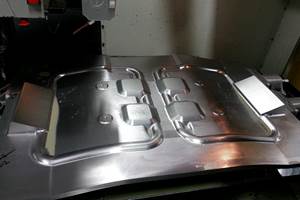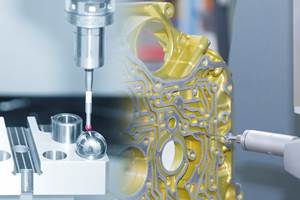How to Get Form Measurements Right, Part 2: Avoiding Measurement Mistakes
Avoid these five form-measurement mistakes.
Share





This is the final part of a series discussing the steps to take to get form measurements correct. For the previous installment, click the link below:
Part One: Recognize the Source of Errors
Relying on Filter Default Values
Geometry measurement exhibits variation from several influences. A part’s true form is influenced by variations in the manufacturing process, including clamping and tool chatter. There are also variables in the measuring process, including setup accuracy, part clamping and environmental influences.
Each influence produces a pattern of undulations generated by the part trace. Bad leveling will make a part appear to have a two-lobed condition. The dynamics of the centerless grinding process typically impose an odd number of undulations per revolution (UPR). Bearing vibration in the machine tool spindle might also add a larger number of undulations.
Geometry gages incorporate electronic filters to simplify the trace by eliminating undulations that appear outside of certain desired frequency bands. A trace can be generated to show only undulations that occur between 0 and 15 times per revolution. This trace reveals low-frequency errors, mostly due to clamping and setup factors. Or, frequencies above 125 UPR can be filtered to include the results of more dynamic factors in the analysis.
Standards establish 50 UPR as a default value for out-of-roundness measurements. With the 50-UPR filter, undulations that occur at frequencies above 50 UPR are filtered out. Use of this filter is appropriate for many, but not all, applications.
Some rotating parts may produce undesirable noise if higher-frequency undulations exceed certain amplitudes, so it may be necessary to filter gaged data for up to 150 or 500 UPR, or even to analyze gage data without electronic filtering. A part designer should define the frequency filter to be used based on the needs of the application.
The Wrong Reference Circle
Out-of-roundness is measured by comparing profile irregularities to a gage spindle’s axis of rotation by means of one of the following four reference circles: maximum inscribed circle, minimum circumscribed circle, least squares circle and the minimal radial separation methods. Results generated by these four approaches can differ by as much as 10 to 15 percent when evaluating the same profile.
Today, PC-driven geometry gages offer all four methods. Part designers should specify the method best suited to the application.
Confusing Scale Effect
The trace of a roundness measurement, as shown on a gage’s computer screen, rarely looks “round.” It usually looks like a mass of sharp peaks and valleys. This can distress users who believe that the chart shows terrible part geometry.
The solution provided by gage manufacturers has been to normalize the part dimension to a fixed-size circle on a screen. This may involve a low level of magnification for small parts or even a reduction in scale for large parts. Deviation is highly magnified, from 1,000× to 20,000× or more.
Geometry gages allow a user to select a magnification level. Even though the computer’s trace does not accurately depict the part’s actual profile, the relationship between peak heights and valley depths remain consistent with the level of magnification chosen. Peaks and valleys also retain accurate angular relationships to one another around the circumference.
The Wrong Signal Processing Filter
The original filters used in geometry measurements—known as double resistor-capacitor (2RC) filters—were designed before the age of digital electronics. When computers were applied in geometry gaging, new digital filters were designed to simulate the response of the analog devices to generate results consistent with those from earlier gages. These quasi-analog filters are still in use today.
The newest geometry gages incorporate 50 percent Gaussian filters that use true digital signal processing methods. (Gaussian refers to the bell-curve shape of the processed signal; the 50-percent figure refers to the amplitude cutoff.) These new filters are more accurate than 2RC filters and create less signal distortion. Again, the design engineers will specify which filters to use.
Ignoring Advanced Gage Functions
Advanced metrology software can tell a user much more than simply whether a part is within tolerance, which is the primary concern of the typical operator. In the hands of a skilled quality assurance technician, an in-depth analysis may help determine what is wrong in a production process, help correct it, and may even predict the performance of a “bad” part if it is installed.
For example, slope analysis is an advanced analysis feature in part geometry. “Slope” is the rate of change of the radius with respect to the angle of rotation. If the longest and shortest radii occur within just a few degrees of rotation of one another, the slope connecting the two points on the circumference will be steep. On the other hand, if the longest and shortest radii occur diametrically opposite one another, the slope will be gradual. A given amount of out-of-roundness may be acceptable in some applications in which the slope is gradual but unacceptable if the slope is steep.
In addition, while filtering techniques enable users to view the effect on out-of-roundness of several undulations within a relatively broad frequency, harmonic analysis enables a user to focus on a single harmonic or frequency.
Geometry gaging can help manufacturers improve the quality and functionality of their designs, but some investment in training is required to reap the rewards.
Related Content
6 Variations That Kill Productivity
The act of qualifying CNC programs is largely related to eliminating variations, which can be a daunting task when you consider how many things can change from one time a job is run to the next.
Read More4 Tips for Staying Profitable in the Face of Change
After more than 40 years in business, this shop has learned how to adapt to stay profitable.
Read MoreRethink Quality Control to Increase Productivity, Decrease Scrap
Verifying parts is essential to documenting quality, and there are a few best practices that can make the quality control process more efficient.
Read MoreHow to Mitigate Risk in Your Manufacturing Process or Design
Use a Failure Mode and Effect Analysis (FMEA) form as a proactive way to evaluate a manufacturing process or design.
Read MoreRead Next
Last Chance! 2025 Top Shops Benchmarking Survey Still Open Through April 30
Don’t miss out! 91ÊÓƵÍøÕ¾ÎÛ's Top Shops Benchmarking Survey is still open — but not for long. This is your last chance to a receive free, customized benchmarking report that includes actionable feedback across several shopfloor and business metrics.
Read MoreAMRs Are Moving Into Manufacturing: 4 Considerations for Implementation
AMRs can provide a flexible, easy-to-use automation platform so long as manufacturers choose a suitable task and prepare their facilities.
Read MoreMachine Shop MBA
Making Chips and 91ÊÓƵÍøÕ¾ÎÛ are teaming up for a new podcast series called Machine Shop MBA—designed to help manufacturers measure their success against the industry’s best. Through the lens of the Top Shops benchmarking program, the series explores the KPIs that set high-performing shops apart, from machine utilization and first-pass yield to employee engagement and revenue per employee.
Read More






















